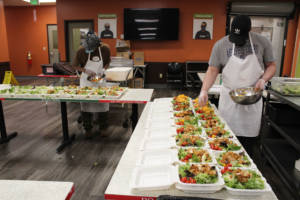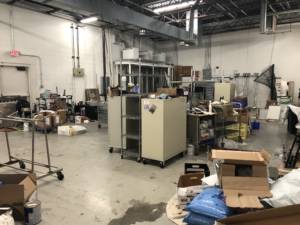The next few months at Second Helpings will be busy as the organization works to expand the Hunger Relief program in response to the need for food remaining above pre-pandemic levels.

Social distancing continues to be enforced at Second Helpings, but it does limit the number of volunteers that can be accommodated in each space.
When coronavirus reached central Indiana, Second Helpings saw many regular agency partners – afterschool programs, senior centers, and others, abruptly close their doors. Those organizations were quickly replaced by new partners – low-income senior housing, mass food distribution programs, and more. Second Helpings addressed the additional challenges presented by social distancing by preparing take-home meals in individual and family-sized packages. At the peak of the first wave of COVID, Second Helpings delivered more than 50,000 meals weekly, twice its normal operating capacity.
Second Helpings’ internal operating capacity continues to be limited by social distancing. Prep tables that once accommodated 5-6 volunteers are now limited to 3, while shifting to individually packaged meals is more labor intensive and requires more space for preparation and packaging.
In March 2021, Second Helpings saw an increase in demand, marking the highest level of meal distribution since June 2020. This rise was due to the continuation of services to agencies added since COVID, while agencies that closed their doors in March 2020 began resuming meals. More programs have returned for summer including youth camping and enrichment programs.
While Second Helpings expected that some partnerships developed over the past year would continue, the “reopening” of programs that have been closed for 16 months has significant ramifications for Second Helpings.
Second Helpings is moving forward with a stabilization plan this summer to ensure the organization can produce the number of meals still needed for partner agencies that have joined since COVID and those that have been long-standing partners.
The stabilization plan includes the following:
- Thoughtful conversations with new COVID relief agency partners to develop step-down plans.
We’re talking with agencies that either began or increased meal services within the past year, to understand their long-term plans and to identify and continue unduplicated and necessary meal deliveries that are core to Second Helpings’ mission.
- Phase-out satellite kitchen operations.
We’re working closely with satellite kitchen partners to plan reductions in their production volumes and ultimately transfer those meals to Second Helpings’ Hunger Relief kitchen.
-

Later this year, the small warehouse will be converted into additional prep space for Second Helpings meals.
Facility improvements to add prep area and refrigeration capacity.
Several capital improvements are planned on our existing property to be completed this fall to allow Second Helpings to absorb meals being produced by satellite kitchens and those required by the return of pre-pandemic agency programs. Those improvements include converting warehouse space to provide an additional flexible food prep area, and constructing a storage building adjacent to the parking lot to replace storage and parking space lost to other improvements.
- Additional volunteer recruitment efforts.
Volunteers have always been at the core of Second Helpings’ ability to serve our community efficiently and effectively and the need for volunteers is greater than ever. If you aren’t already a Second Helpings volunteer, please consider joining us and share volunteer opportunities at Second Helpings with friends and colleagues.
- Added staff in Food Rescue and Hunger Relief to address higher volumes.
The Hunger Relief program’s onsite operations currently produce an average of 21,500 meals a week. Through this stabilization plan and with these improvements, estimates are that with social distancing, output could be increased by as much as 6,500 meals a week, or 30%.
These improvements address Second Helpings’ near-term capacity needs. With the upcoming retirement of CEO Jennifer Vigran this fall, it gives the Board and new CEO time to evaluate and plan for the future.
As Second Helpings moves forward with this plan, we’ll have more updates and photos to share. On behalf of the Board, staff, and the thousands we serve every day, thank you for your continued support.
